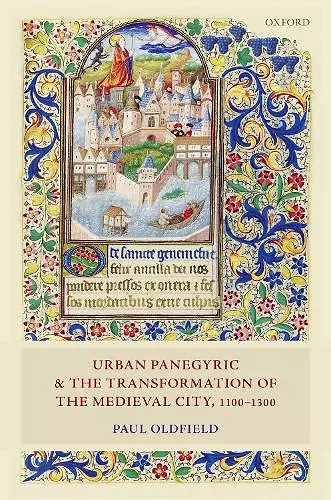Urban Panegyric and the Transformation of the Medieval City, 1100-1300
Format:Hardback
Publisher:Oxford University Press
Published:3rd Jan '19
Should be back in stock very soon

This study offers the first extensive analysis of the function and significance of urban panegyric in the Central Middle Ages, a flexible literary genre which enjoyed a marked and renewed popularity in the period 1100 to 1300. In doing so, it connects the production of urban panegyric to major underlying transformations in the medieval city and explores praise of cities primarily in England, Flanders, France, Germany, Iberia, and Italy (including the South and Sicily). The volume demonstrates how laudatory ideas on the city appeared in extremely diverse textual formats which had the potential to interact with a wide audience via multiple textual and material sources. When contextualized within the developments of the twelfth and thirteenth centuries these ideas could reflect more than formulaic, rhetorical outputs for an educated elite, they were instead integral to the process of urbanisation. In Urban Panegyric and the Transformation of the Medieval City, 1100-1300, Paul Oldfield assesses the generation of ideas on the Holy City, on counter-narratives associated with the Evil City, on the inter-relationship between the City and abundance (primarily through discourses on commercial productivity, hinterlands and population size), on landscapes and sites of power, and on knowledge generation and the construction of urban histories. Urban panegyric can enable us to comprehend more deeply material, functional, and ideological change associated with the city during a period of notable urbanization, and, importantly, how this change might have been experienced by contemporaries. This study therefore highlights the importance of urban panegyric as a product of, and witness to, a period of substantial urban change. In examining the laudatory depiction of medieval cities in a thematic analysis it can contribute to a deeper understanding of civic identity and its important connection to urban transformation.
Paul Oldfield has masterfully written an accessible academic work appropriate for advanced scholars and novice students alike. One aspect of his work that especially impressed this reader was the accessibility of each chapter, which can be read as an independent essay, providing an incredible resource for educators in a broad range of fields from medieval urban studies to early vernacular literature. * Hannah Maryan Thomson, Comitatus *
That Oldfield's book suggests us to ask many new questions for further research is an indication of its qualities...This is an important book, which may prove to become even more important when scholars of other regions and centuries seek to test its thesis. * Professor Marco Mostert, University of Utrecht, Reviews in History *
This is an important book, which may prove to become even more important when scholars of other regions and centuries seek to test its thesis. * Professor Marco Mostert, University of Utrecht, Reviews in History *
ISBN: 9780198717737
Dimensions: 236mm x 164mm x 19mm
Weight: 490g
226 pages